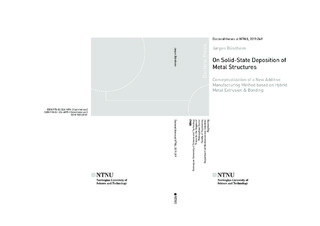| dc.contributor.advisor | Steinert, Martin | |
| dc.contributor.advisor | Welo, Torgeir | |
| dc.contributor.author | Blindheim, Jørgen | |
| dc.date.accessioned | 2019-10-02T08:47:10Z | |
| dc.date.available | 2019-10-02T08:47:10Z | |
| dc.date.issued | 2019 | |
| dc.identifier.isbn | 978-82-326-4095-9 | |
| dc.identifier.issn | 1503-8181 | |
| dc.identifier.uri | http://hdl.handle.net/11250/2619798 | |
| dc.description.abstract | This thesis presents the conceptualization of a new solid-state process for additive manufacturing (AM) of extrudable metals and alloys. The process is based on the Hybrid Metal Extrusion & Bonding (HYB) technology and has been termed HYB-AM.
The main objective of this thesis has been to develop the HYB-AM process through concept evaluation and full-scale experimental testing, hence making it possible to assess the mechanical integrity of a deposited structure and understand the governing mechanisms of the process.
A novel set-based approach for concept evaluation has been developed and applied. The combination of rapid prototyping and physical modelling made it possible to test and evaluate multiple extruder and deposition concepts without having to build full-scale steel prototypes. Plastic models of the different extruder concepts were produced by rapid prototyping and attached to a small CNC-machine. To test the function of each design, plasticine was processed through the different extruders and deposited on the machine bed. Through the evaluation of all the modelled concepts the extruder design for full-scale testing was identified.
Full-scale experiments have been carried out for two different extruder designs. Through the fabrication of samples and the subsequent assessment of the layer bonding, the technical feasibility of the HYB-AM process has been conclusively demonstrated in producing mechanically sound 3D structures. The results from the mechanical testing display an ultimate tensile strength across the bonded layers approaching that of the substrate material, yet at lower elongation prior to fracture. Moreover, inspections of the fracture surfaces show evidence of extensive dimple formation. This indicates that metallic bonding is achieved between the layers. However, regions of kissing-bonds and lack of bonding are also present, thus calling for further process optimization.
A novel method for fabrication of tensile specimens for assessing the bond strength between the layers has been developed and applied. The miniature specimens are machined from the samples using a single thread milling tool. In this way, the specimens can be located such that the interface between separate layers crosses the reduced section of the specimens. This allows the bond strength between the layers to be
tested in pure tension. FEA has been used to study material flow in the extruder, as well as the conditions at the interfaces of the deposited extrudate and the substrate in order to identify and characterize the process parameters involved.
Analysis of the material flow, shows that the extrusion pressure is virtually independent of the deposition rate. Furthermore, from the simulations of the material deposition sequence it is visible how the contact pressure at the interface will drop below the bonding threshold if the feed speed becomes too high relative to the material flow through the die.
The results obtained in this work, will be useful in the further development towards industrialization of the process. Although this work has demonstrated the process in full scale and established an understanding of the process, further research is required prior to industrialization. | nb_NO |
| dc.language.iso | eng | nb_NO |
| dc.publisher | NTNU | nb_NO |
| dc.relation.ispartofseries | Doctoral theses at NTNU;2019:249 | |
| dc.relation.haspart | Paper 1: Blindheim, Jørgen; Grong, Øystein; Aakenes, Ulf Roar; Welo, Torgeir; Steinert, Martin. Hybrid Metal Extrusion & Bonding (HYB) - a new technology for solid-state additive manufacturing of aluminium components. Procedia Manufacturing 2018 ;Volum 26. s. 782-789
- Published with a creative commons license (CC BY-NC-ND 4.0)
https://doi.org/10.1016/j.promfg.2018.07.092 | nb_NO |
| dc.relation.haspart | Paper 2:
Blindheim, Jørgen; Welo, Torgeir; Steinert, Martin.
Rapid prototyping and physical modelling in the development of a new additivemanufacturing process for aluminium alloys.
Procedia Manufacturing
Volume 34, 2019, Pages 489-496
- Published with a creative commons license (CC BY-NC-ND 4.0)
https://doi.org/10.1016/j.promfg.2019.06.212 | nb_NO |
| dc.relation.haspart | Paper 3:
Blindheim, Jørgen; Elverum, Christier; Welo, Torgeir; Steinert, Martin.
Concept evaluation in new product development: A set-based method utilizing rapid prototyping and physical modelling. | nb_NO |
| dc.relation.haspart | Paper 4:
Blindheim, Jørgen; Welo, Torgeir; Steinert, Martin.
First demonstration of a new additive manufacturing process based on metal extrusion and solid-state bonding.
- This is a post-peer-review, pre-copyedit version. The final authenticated version is available online at:
http://doi.org/10.1007/s00170-019-04385-8 | nb_NO |
| dc.relation.haspart | Paper 5: On the mechanical integrity of AA6082 3D structures deposited by hybrid metal extrusion & bonding additive manufacturing. | nb_NO |
| dc.relation.haspart | Paper 6: Investigating theMechanics of HybridMetal Extrusion & Bonding AdditiveManufacturing by FEA
- This article is an open access
article distributed under the terms and conditions of the Creative Commons Attribution
(CC BY) license
https://doi.org/10.3390/met9080811 | nb_NO |
| dc.title | On Solid-State Deposition of Metal Structures: Conceptualization of a New Additive Manufacturing Method based on Hybrid Metal Extrusion & Bonding | nb_NO |
| dc.type | Doctoral thesis | nb_NO |
| dc.subject.nsi | VDP::Technology: 500::Mechanical engineering: 570 | nb_NO |

